technical specifications Seat Ibiza ST 2013 Repair Manual
[x] Cancel search | Manufacturer: SEAT, Model Year: 2013, Model line: Ibiza ST, Model: Seat Ibiza ST 2013Pages: 294, PDF Size: 4.05 MB
Page 125 of 294
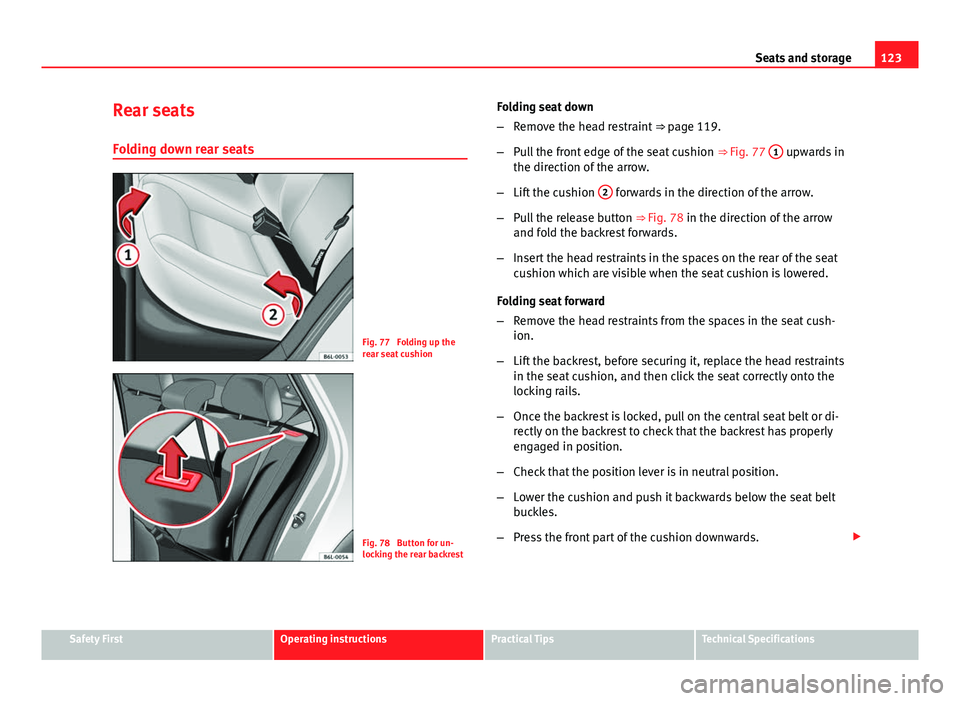
123
Seats and storage
Rear seats
Folding down rear seats
Fig. 77 Folding up the
rear seat cushion
Fig. 78 Button for un-
locking the rear backrest Folding seat down
β
Remove the head restraint ββpage 119.
β Pull the front edge of the seat cushion ββFig. 77 1
upwards in
the direction of the arrow.
β Lift the cushion 2
forwards in the direction of the arrow.
β Pull the release button ββFig. 78 in the direction of the arrow
and fold the backrest forwards.
β Insert the head restraints in the spaces on the rear of the seat
cushion which are visible when the seat cushion is lowered.
Folding seat forward
β Remove the head restraints from the spaces in the seat cush-
ion.
β Lift the backrest, before securing it, replace the head restraints
in the seat cushion, and then click the seat correctly onto the
locking rails.
β Once the backrest is locked, pull on the central seat belt or di-
rectly on the backrest to check that the backrest has properly
engaged in position.
β Check that the position lever is in neutral position.
β Lower the cushion and push it backwards below the seat belt
buckles.
β Press the front part of the cushion downwards. ο£
Safety FirstOperating instructionsPractical TipsTechnical Specifications
Page 127 of 294

125
Seats and storage
Storage compartment
Storage compartment on the front passenger side
Fig. 79 Passenger side:
storage compartment
Fig. 80 Storage com-
partment for instruction
manual
The compartment can be opened by pulling the lever ββFig. 79.This compartment can hold documents in A4 format, a water bottle of 1.5
L,...
WARNING
Always keep the storage compartment cover closed while the vehicle is
in motion in order to reduce the risk of injury caused by a sudden braking
or by an accident.
ο
Storage compartment on the driver side
There is a storage compartment on the driver side
Fig. 81 Driver side com-
partment ο
Safety FirstOperating instructionsPractical TipsTechnical Specifications
Page 129 of 294

127
Seats and storage
Seat storage pocket*
Fig. 85 Seat storage
pocket
There is a storage pocket on the rear of the front seats. ο
Storage compartment in the front door panel*
In this storage compartment a 1.5l water bottle can be stored,... οFront drink holder*
Fig. 86 Front drink hold-
ers in the centre console
There are two cup holders in the centre console in front of the gearbox lever
ββ Fig. 86.
WARNING
β Do not put hot drinks in the drink holders. During normal or sudden
driving manoeuvres, sudden braking or an accident, the hot drink could
be spilled. Danger of scalding.
β Never use rigid materials (for example, glass or ceramic), these could
cause injury in the case of an accident.
β When travelling the drink holder should always be closed to prevent
risk in the event of sudden breaking or accident.
ο
Safety FirstOperating instructionsPractical TipsTechnical Specifications
Page 131 of 294

129
Seats and storage
Cigarette lighter*
Fig. 89 Lighter
β Press on the cigarette lighter ββFig. 89 to activate it ββ
.
β Wait for the lighter to spring out.
β Pull out the cigarette lighter and light the cigarette on the glow-
ing coil.
WARNING
β Improper use of the cigarette lighter can lead to serious injuries or
start a fire.
β Using the lighter carefully. Carelessness or negligence when using
the cigarette lighter can cause burns and serious injuries.
β The lighter only works when the ignition is turned on or the engine is
running. To avoid the risk of fire, never leave children alone inside the ve-
hicle.
ο Power socket
Fig. 90 Front power
socket
The 12 Volt cigarette lighter power socket can also be used for other electri-
cal components with a power rating of up to 120 Watt. When the engine is
switched off, however, the vehicle battery will discharge. For further infor-
mation see ββpage 196.
WARNING
The power sockets and the connected accessories will only operate when
the ignition is on or when the engine is running. Improper use of the
sockets or electrical accessories can lead to serious injuries or cause a
fire. To avoid the risk of injury, never leave children alone inside the vehi-
cle.
Note
β The use of electrical appliances with the engine switched off will cause a
battery discharge.
β Before using any electrical accessories, see the instructions in
ββpage 196. ο
Safety FirstOperating instructionsPractical TipsTechnical Specifications
Page 133 of 294

131
Seats and storage
AUX/USB input connection*
Fig. 93 AUX/USB input
connection (depending
on the equipment)
For information concerning the use of this equipment, please see the Radio
handbook. ο
First-aid kit, warning triangle, fire
extinguisher* First-aid kit, warning triangle and fire extinguisher
The use of reflective warning triangles is obligatory in emergencies in some
countries. As are the first aid kit and a set of spare light bulbs.
The first-aid kit and the fire extinguisher are located in the luggage com-
partment, held in place by Velcro.
Note
β The first aid kit, the warning triangles and the fire extinguisher are not
supplied with the vehicle as standard.
β The first aid kit, the warning triangles and the fire extinguisher should
meet legal requirements.
β The expiry date of the content of the first aid kit should be checked.
β Ensure that the fire extinguisher is fully functional. The fire extinguisher
should, therefore, be checked regularly. The sticker on the fire extinguisher
will inform you of the next date for checking.
β Before purchasing accessories and spare parts, see the instructions in
ββpage 196, Accessories, replacement of parts and modifications. ο
Applies to the model: IBIZA ST Warning triangle*
Fig. 94 Housing for the
emergency warning trian-
gle in the luggage com-
partment.
The warning triangle is under the storage compartment which is located un-
der the luggage compartment floor. ο£
Safety FirstOperating instructionsPractical TipsTechnical Specifications
Page 135 of 294
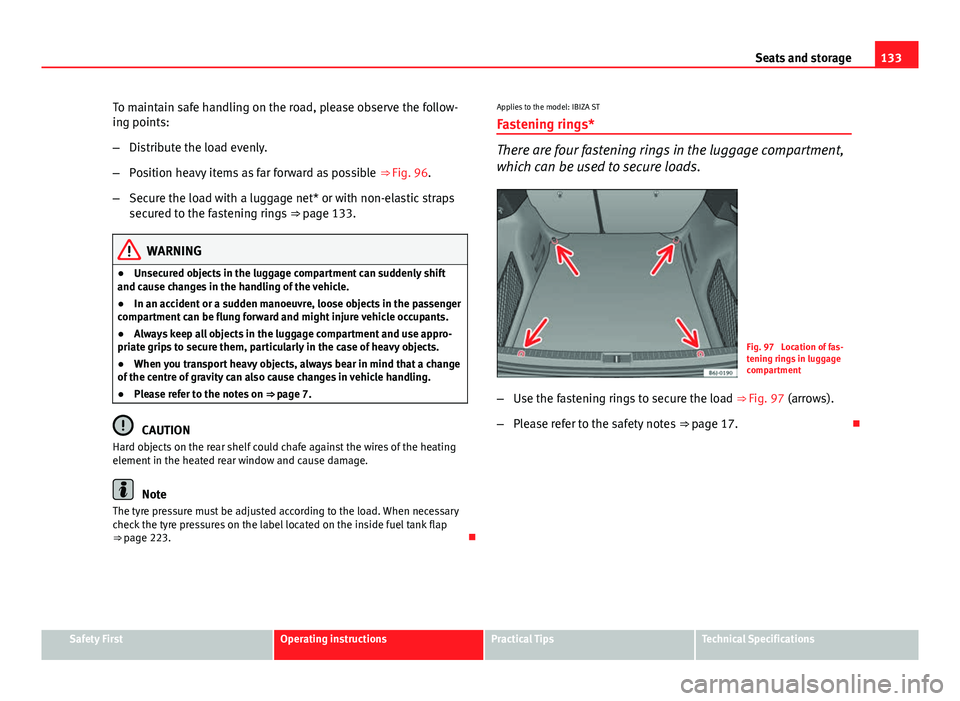
133
Seats and storage
To maintain safe handling on the road, please observe the follow-
ing points:
β Distribute the load evenly.
β Position heavy items as far forward as possible ββFig. 96.
β Secure the load with a luggage net* or with non-elastic straps
secured to the fastening rings ββpage 133.
WARNING
β Unsecured objects in the luggage compartment can suddenly shift
and cause changes in the handling of the vehicle.
β In an accident or a sudden manoeuvre, loose objects in the passenger
compartment can be flung forward and might injure vehicle occupants.
β Always keep all objects in the luggage compartment and use appro-
priate grips to secure them, particularly in the case of heavy objects.
β When you transport heavy objects, always bear in mind that a change
of the centre of gravity can also cause changes in vehicle handling.
β Please refer to the notes on ββpage 7.
CAUTION
Hard objects on the rear shelf could chafe against the wires of the heating
element in the heated rear window and cause damage.
Note
The tyre pressure must be adjusted according to the load. When necessary
check the tyre pressures on the label located on the inside fuel tank flap
ββpage 223. οApplies to the model: IBIZA ST
Fastening rings*
There are four fastening rings in the luggage compartment,
which can be used to secure loads.
Fig. 97 Location of fas-
tening rings in luggage
compartment
β Use the fastening rings to secure the load ββFig. 97 (arrows).
β Please refer to the safety notes ββpage 17. ο
Safety FirstOperating instructionsPractical TipsTechnical Specifications
Page 137 of 294

135
Seats and storage
Note
β Ensure that, when placing items of clothing on the luggage compart-
ment cover, rear visibility is not reduced. ο
Applies to the model: IBIZA ST Rear shelf with storage compartment*
Fig. 100 Removing stor-
age compartment
Fig. 101 Accessing stor-
age compartment
To remove the storage compartment
β Remove the rear shelf and pull the storage compartment up-
wards holding it by the edges ββFig. 100.
The storage compartment can be accessed from the rear seats by lifting the
front side of the rear shelf ββFig. 101.
WARNING
Do not place heavy or hard objects on the rear shelf, because they will
endanger the vehicle occupants in case of sudden braking.
CAUTION
β Before closing the rear lid, ensure that the rear shelf is correctly fitted.
β An overloaded luggage compartment could mean that the rear shelf is
not correctly seated and it may be bent or damaged.
β If the luggage compartment is overloaded, remove the tray.
β The load in the storage compartment should not exceed 3 kg. ο£
Safety FirstOperating instructionsPractical TipsTechnical Specifications
Page 139 of 294
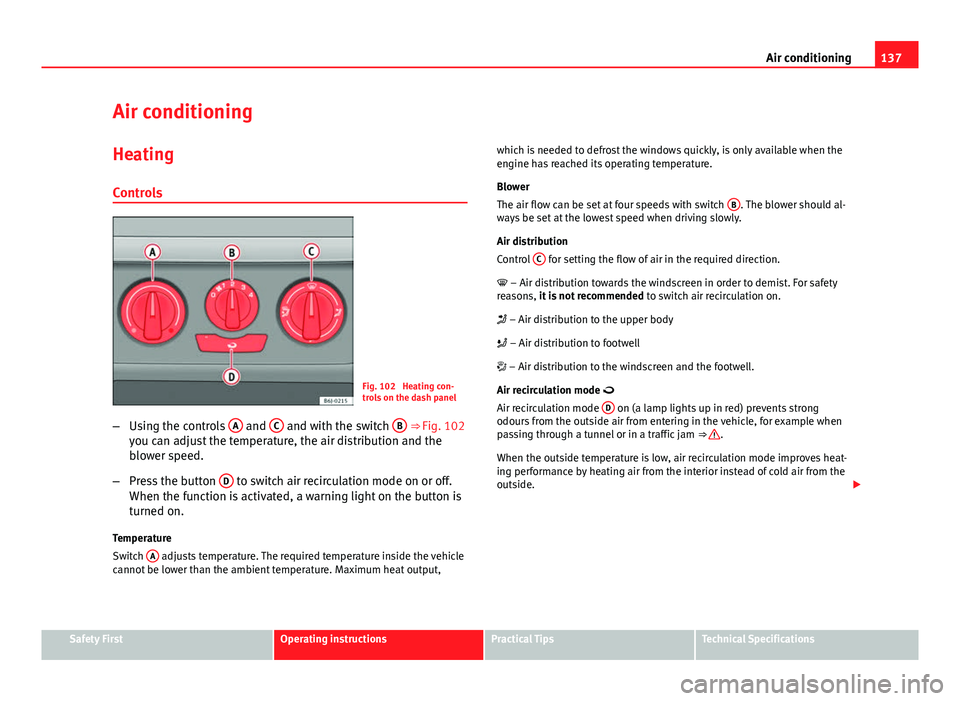
137
Air conditioning
Air conditioning Heating
Controls
Fig. 102 Heating con-
trols on the dash panel
β Using the controls A
and C and with the switch B ββFig. 102
you can adjust the temperature, the air distribution and the
blower speed.
β Press the button D
to switch air recirculation mode on or off.
When the function is activated, a warning light on the button is
turned on.
Temperature
Switch A
adjusts temperature. The required temperature inside the vehicle
cannot be lower than the ambient temperature. Maximum heat output, which is needed to defrost the windows quickly, is only available when the
engine has reached its operating temperature.
Blower
The air flow can be set at four speeds with switch
B
. The blower should al-
ways be set at the lowest speed when driving slowly.
Air distribution
Control C
for setting the flow of air in the required direction.
ο β Air distribution towards the windscreen in order to demist. For safety
reasons, it is not recommended to switch air recirculation on.
ο± β Air distribution to the upper body
ο² β Air distribution to footwell
ο« β Air distribution to the windscreen and the footwell.
Air recirculation mode ο
Air recirculation mode D
on (a lamp lights up in red) prevents strong
odours from the outside air from entering in the vehicle, for example when
passing through a tunnel or in a traffic jam ββ
.
When the outside temperature is low, air recirculation mode improves heat-
ing performance by heating air from the interior instead of cold air from the
outside. ο£
Safety FirstOperating instructionsPractical TipsTechnical Specifications
Page 141 of 294
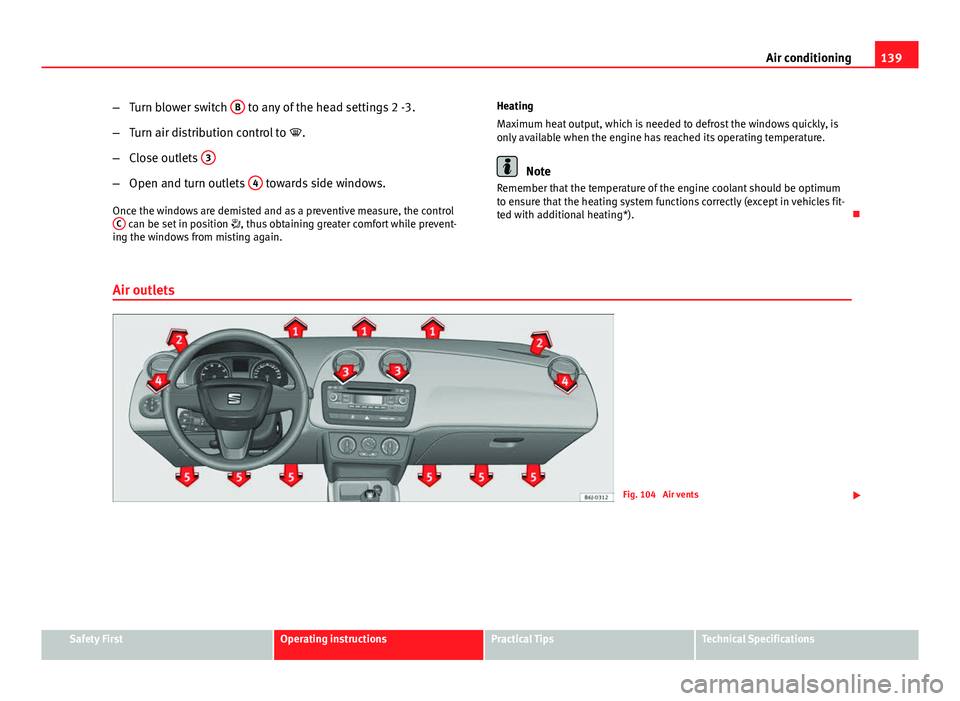
139
Air conditioning
β Turn blower switch B
to any of the head settings 2 -3.
β Turn air distribution control to ο.
β Close outlets 3
β
Open and turn outlets 4 towards side windows.
Once the windows are demisted and as a preventive measure, the control C
can be set in position οΆ, thus obtaining greater comfort while prevent-
ing the windows from misting again. Heating
Maximum heat output, which is needed to defrost the windows quickly, is
only available when the engine has reached its operating temperature.
Note
Remember that the temperature of the engine coolant should be optimum
to ensure that the heating system functions correctly (except in vehicles fit-
ted with additional heating*). ο
Air outlets
Fig. 104 Air vents ο£
Safety FirstOperating instructionsPractical TipsTechnical Specifications
Page 143 of 294
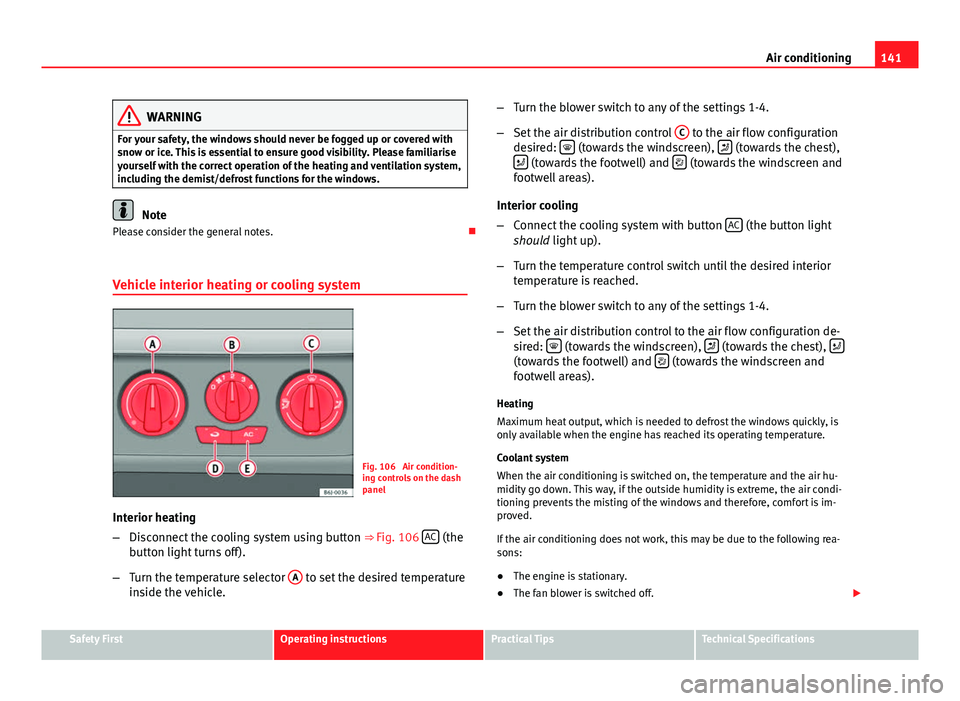
141
Air conditioning
WARNING
For your safety, the windows should never be fogged up or covered with
snow or ice. This is essential to ensure good visibility. Please familiarise
yourself with the correct operation of the heating and ventilation system,
including the demist/defrost functions for the windows.
Note
Please consider the general notes. ο
Vehicle interior heating or cooling system
Fig. 106 Air condition-
ing controls on the dash
panel
Interior heating
β Disconnect the cooling system using button ββFig. 106 AC
(the
button light turns off).
β Turn the temperature selector A
to set the desired temperature
inside the vehicle. β
Turn the blower switch to any of the settings 1-4.
β Set the air distribution control C
to the air flow configuration
desired: ο (towards the windscreen), ο± (towards the chest),
ο² (towards the footwell) and ο« (towards the windscreen and
footwell areas).
Interior cooling
β Connect the cooling system with button AC
(the button light
should light up).
β Turn the temperature control switch until the desired interior
temperature is reached.
β Turn the blower switch to any of the settings 1-4.
β Set the air distribution control to the air flow configuration de-
sired: ο
(towards the windscreen), ο± (towards the chest), ο²(towards the footwell) and ο« (towards the windscreen and
footwell areas).
Heating
Maximum heat output, which is needed to defrost the windows quickly, is
only available when the engine has reached its operating temperature.
Coolant system
When the air conditioning is switched on, the temperature and the air hu-
midity go down. This way, if the outside humidity is extreme, the air condi-
tioning prevents the misting of the windows and therefore, comfort is im-
proved.
If the air conditioning does not work, this may be due to the following rea-
sons:
β The engine is stationary.
β The fan blower is switched off. ο£
Safety FirstOperating instructionsPractical TipsTechnical Specifications